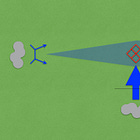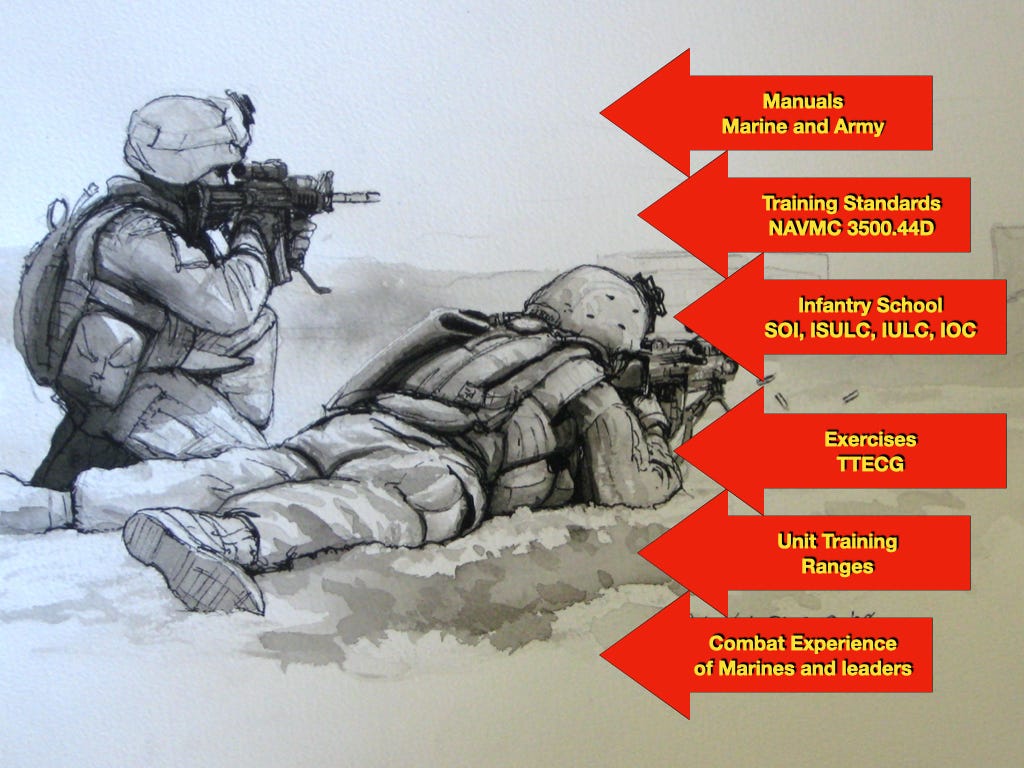With this article, the Tactical Notebook continues the serialization of Three Hundred Assaults. Written by Lieutenant Colonel Brendan McBreen, USMC (Retired), Three Hundred Assaults explores the results of an ambitious program of simulations, each of which depicted an assault conducted by a Marine rifle squad. The first two posts in this series can be found at the other end of the following links.
2. Where are the answers?
Questions on tactics make great conversation for Marine leaders. New Marines depend on their leaders to prepare them for combat and to train them well—tough, repetitively, and realistically. Marines will fight the way they are trained—by our manuals, training standards, schools, exercises, units, and combat-experienced leaders—for that one day when they may have to assault the enemy.
“The end for which a soldier is recruited, clothed, armed, and trained, the whole object of his sleeping, eating, drinking, and marching, is simply that he should fight at the right place and the right time.”
Carl von Clausewitz, On War
“The right place and the right time” for the entire Marine Corps is closing on the objective with the assault element. Everything we do—manning, training, and equipping—and every capability we field—aviation, artillery, intelligence, reconnaissance, comm, engineers—exists solely to get our infantry squad leader and his Marines into the trench or into the building to destroy the enemy.
So what does the Marine Corps teach? What assault techniques work best? Under what conditions? How to we teach leaders to read the terrain? To assess enemy actions? How do we teach units and leaders to maneuver under fire? What factors are most critical for a successful assault? What decisions have to be made by small-unit leaders? What commands are given? What are our best practices for the assault? Where are these answers?
Marines FIGHT like they are TRAINED
2.1. In our manuals?
Our MCRP 3-10A.4 Marine Rifle Squad (2020) manual does NOT explain how to conduct a squad assault. There is no overall explanation of various assault techniques, which action is best in what situation, or what decisions the squad leader needs to make. The procedural paragraphs on how to move from the assault position, and then conduct fire and movement, assault fire, and close combat are poorly written, disjointed, and confusing. There are no diagrams.
The manual focuses on static definitions and control measures, not useful procedures. When it doesn’t know what to say, it reverts to empty phrases that tell the squad leader nothing. “The assault is launched aggressively…” How? “Assault fire is characterized by violence, volume, and accuracy…” When? “[Marines] put themselves in a position of advantage…” Where?
Fire and movement, the most important assault technique, is explained badly in two separate and contradictory paragraphs without pictures. Page 3-14 describes fire and movement for fire teams, but page 1-24 focuses on the buddy-team, ignoring the squad. The importance of massed fire team suppression, the ability to read terrain, and the danger of fratricide—none of these are explained. The technique of assault fire is mentioned on random pages (1-10, 1-15, 1-25, 3-15), but never described. Close combat, fighting through the objective, is only hinted at on pages 1-15 and 1-25.
No other manual makes up for the gaps in our squad manual. MCRP 3-10A.3 Marine Infantry Platoon (2020), MCRP 3-10A.2 Infantry Company Operations (2018), MCTP 3-01A Scouting and Patrolling (2020), and MCWP 3-01 Offensive and Defensive Tactics (2019) offer no additional guidance on the assault.
Both the Army’s ATP 3-21.8 Infantry Platoon and Squad (2016) and TC 3-21.76 Ranger Handbook (2017) are better written and include battle drills that describe fire and movement. Their focus is on the fire team, the smallest unit that can actually suppress the enemy. Although assault fire is mentioned on page F-23 of the ATP 3-21.8, the term is not defined in any DOD, Army or Marine Corps dictionary. The British (2009) and Canadian (1996) army manuals for squad and platoon are both clearer, consistent, and better illustrated than ours, and written for their audience in a straightforward, ‘how-to’ manner. Our squad manual needs to be improved.
2.2. In our training standards?
Our training standards do NOT define a successful squad assault. The Infantry Training and Readiness Manual (2020), defines the standard for a platoon attack (INF-MAN-5001 Conduct an Attack, page 6-14), and the squad standard to support this task (INF-MAN-4014 Support by Fire, page 7-23), but there is NO squad-level standard for the assault—the critical task that makes the attack successful.
There are individual training standards for Marines, and standards for infantry leaders, whether squad leaders, staff non-commissioned officers, or officers — who lead units in the attack. There is a fire team standard (INF-MAN-3001 Conduct Fire and Movement, page 7-47) and a related squad standard (INF-MAN-4001 Conduct an Attack, page 7-12) for a standalone squad attack, but neither of these define a squad assault as part of a platoon attack.
We need a training standard for the squad assault that addresses multiple assault techniques. For fire and movement, the standard should be “close to within grenade range (20 meters) of the enemy position without getting shot.” Performance steps should include “suppress until there is no return fire,” “move only when suppression is firing,” “select and move from one covered position to another,” and “avoid moving outside mutual support (behind a building or over a crest).”
Standards for leaders of the assault should address selecting the best route for the assault, identifying and communicating the location of the enemy using fire commands, controlling the movement of fire teams, and making tactical decisions and directing units under fire with voice, radio, and hand and arm signals.
Training standards are generated from manuals. If we improve our manuals, we will improve our training standards.
2.3. In our schools?
Our schools teach different assault techniques at different courses on different coasts to Marines of different ranks. New Marines are taught fire and movement at the entry-level courses at the Schools of Infantry (SOI). Squad leader 0365s are taught at the Infantry Small Unit Leaders Course (ISULC), and Platoon Sergeant 0369s are taught at the Infantry Unit Leaders Course (IULC). Lieutenants are taught assault techniques at the Basic Schools (TBS) and Infantry Officer Course (IOC).
Our review of school training materials and interviews with instructors show that when the manuals and training standards are insufficient, instructors are forced to augment the training with their own experiences. But some instructors have little experience, standardization is uneven, and some instruction clearly does not address the complex and difficult details of small-unit combat.
School curriculum is generated from training standards and manuals. If we improve our manuals, we will improve our schools.
2.4. In our exercises?
Our exercise controllers do NOT publish guidelines for a successful squad assault. The classes and briefs from the Tactical Training and Exercise Control Group (TTECG) are rightly designed to explain the parameters of a training scenario but not the solutions. Most, but not all, of the events of our service-level training exercises focus on supporting arms coordination for the MAGTF. Large exercises are not designed to train small units.
But the collected experience of our TTECG coyotes is priceless. They do train units on good assault techniques—practical battlefield skills—on multiple ranges, especially 410A, the platoon supported attack. Every month, coyotes observe and mentor units from across the Marines Corps. If a unit has missed something in unit training, the coyotes coach the unit leaders. They assess casualties to reinforce proper execution of suppression, cover, and movement. The techniques that the coyotes teach are the techniques that work. Where are their insights and best practices published?
2.5. In unit training?
Unit training can train Marines on the best techniques to conduct an assault—if the unit leaders know what they are doing. Unit training—Marines training alongside the Marines that they will fight beside in combat—is the only training that matters. The only training that develops strong, cohesive units. Schools train individuals, but unit training builds teams. Unit training, however, depends entirely on the experience and abilities of the leaders who conduct it.
If we improve our manuals and our training standards, we will improve our schools and our leaders. Well-trained leaders build well-trained units.
2.6. In combat?
Marines in combat gain experience fighting real-world enemies. Our organization is stronger today because our leaders have two decades of hard-earned knowledge. Where do we collect and publish this expertise? Since World War II, the Marine Corps has conducted thousands of squad assaults—on pillboxes in the Pacific, hilltops in Korea, bunkers in Vietnam, and insurgent outposts in Afghanistan and Iraq. Our manuals should reflect these eight decades of infantry combat, and explain what tactics, techniques, and procedures (TTPs) work best.
Combat veterans understand that their experience is limited to one enemy in one place at one time. And often during a combat deployment, a Marine will never execute many of the tactics that he has been taught. But our collected wisdom—across multiple decades, conflicts, and adversaries—benefits us all. “That’s how we did it in Iraq” is insufficient as an answer because the future situation and the future enemy is always going to be different.
We surveyed dozens of Marine leaders on the squad assault: 0365 squad leaders, 0369 platoon sergeants, and 0302 platoon and company commanders. Certified combat instructors from SOI and TTECG coyotes. All with years of unit training, overseas deployments, and combat experience. What do we teach our squad leaders? What should we teach? What are the best techniques for the assault? And where are the answers to these questions? Their comments were detailed and thoughtful and all of them raised more questions. Most agreed that the answers to our questions, the detailed steps of conducting a squad assault, were not easily available. But they should be.
If we improve our manuals, both experienced Marines and new Marines will benefit.
2.7. Where else can we learn how to assault?
In simulation. We can simulate an infantry assault on a computer over and over again. General Berger, the Commandant (2019) has stated, “Wargaming needs to be used…to fill…our greatest deficiency in training… practice in decision-making against a thinking enemy… [Wargaming] gives leaders… ‘reps and sets’ in realistic combat decision making.”
Simulations are not real. But all training is not real—classroom, field, and even range training. Experienced professionals need to use their judgement to extract real-world lessons and ignore any unrealities. Simulations have biases and design flaws. But our leaders, trainers, umpires, and coyotes have opinions and biases too. A simulation can never prove or confirm a tactic, but it can provide insights into the various factors that lead to success or failure in a given tactical situation.
Simulations are ideal for repetition, to identify trends and best practices. They enable experimentation, risk-taking, and catastrophic failure. Simulations provide a continuous series of tactical problems that require difficult tactical decisions and generate immediate consequences. Simulations enable us to view our actions from the enemy’s point of view. A realistic simulation helps us internalize lessons on what is important to the fight and what is not.
For Further Reading:









Are the books by H. John Poole still relevant?
Considering how Ukraine seems to be a step back.
I found 'Tactics of the Crescent Moon' very interesting for it’s time.